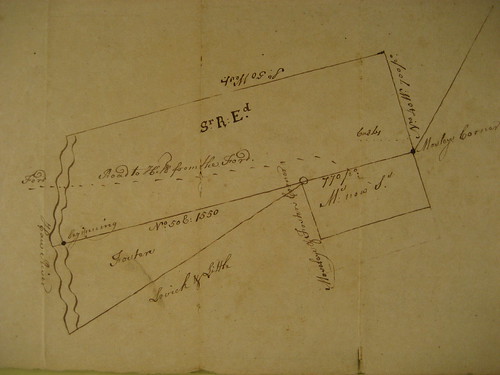So until recently it seemed that no detailed record remained of the grant of 10,000 choice acres in the Hawfields to Gov. Richard Everard. Then I found this in the Devereux Papers at the Archives:

Evidently this is a survey of the land of Sir Richard Everard, with Forster and Moseley shown as neighbors to the south, and with Lovick and Little rather hypothetically shown. This seems to be a survey of the Everard Tract only, as all of property lines for Moseley and Forster are shown schematically – that is the surveyor was making no real assertion about the Forster or Moseley Tracts. Also in one place is says “Mo now St” – Moseley now Strudwick – indicating that the survey was done after Strudwick received the property in 1754.
Considering the terms of the Moseley grant and the Pollock grant, it is clear that the southeastern corner of the Everard Tract was also the northwestern corner of the Pollock Tract. Therefore, using the metes and bounds of the Everard Plat, we can place this tract onto a modern map:
![Everard_Tract[1]](http://farm3.static.flickr.com/2755/4202503186_06437fd24c.jpg)
The ford marked on the plat is therefore clearly Trollinger's Ford, earlier known as the Piney Ford and no doubt known by native names before that.
Everard died in 1733 and the Everard Tract passed to his daughters Anne Everard Lathbury (et ux. George) and Susannah Everard Meade (spouse deceased?) In 1770, Lathbury's 10,000 acres were sold by court order to satisfy a judgment from Halifax Court on an unrelated matter. At the auction, three well-known Hillsborough men, Edmund Fanning, Abner Nash and Thomas Hart, bought the Everard Tract for 670 Pounds (24 S.R. 285; p. 45, 2nd Report of the Ontario Archives, Alexander Fraser, 1904). Only a few years later the Revolution broke out and both Fanning and Hart fled North Carolina.
I take it this refers to Fanning’s 1/3 interest in this parcel: “5000 acres, Hawfields, Orange County, purchased in July, No.19. 1770, of John Butler, valued by Mr. Johnston at 40 sh. Virg. per acre, £10,000 V. Curry.” (p. 45, 2nd Report of the Ontario Archives, Alexander Fraser, 1904). It would have been more accurate to say 3,333 acres, I believe.
Nash worked to disentangle his interest in the Lathbury-Everard Tract from his Loyalist co-adventurers. At least two letters from Nash are still to be found at the State Archives regarding his efforts to get a separate deed for his 1/3 of the property. Ultimately in 1779 Nash got the state legislature to order a division of the land (24 S.R. 285). Few immediately subsequent deeds from Nash can be found today, but it appears that at least part of it went to John Butler (ODB 3, pg 462).
Curiously the Virginia Gazette (6/4/1772) advertised “SEVERAL valuable Tracts of TOBACCO LAND, the Whole consisting of about ten Thousand Acres, well watered, situated on the Waters of Rock Creek and Saxapahaw River, to which is contiguous a very good Summer Range, and many other Advantages. Twelve Tracts, containing from about two Hundred and fifty to six Hundred Acres, are already surveyed, and several more will be when Purchasers offer . . . the Lands are situated in the Haw Fields, twelve Miles beyond Hillsborough, and bounded by Haw River . . . GEORGE LATHBURY, G. WALKER, Attorney for Susanna Meade.”
Additionally, I found a Power of Attorney recorded in the Orange Deed Books from Susanna Meade to G. Walker granting him authority to sell or otherwise manage her interest in 10,000 acres which she co-owned with George Lathbury - plainly the Everard Tract. Susanna Everard Meade was Anne Everard Lathbury’s sister, both daughters of Gov. Everard. Notably this was in 1772, after the property had already sold in 1770 to Fanning et al. Perhaps they did not know about the execution sale or were otherwise attempting to have the execution sale set aside.
Nice bit of historical research, Mark. Excellent modern map that I'm sure is quite accurate. I'd like to see such info as relates to the tract along Millikin Road to the east of Cane Creek (Orange Cty.) Why is it oriented NE? I suspect because of the general flow of the Haw to the SE.
ReplyDelete